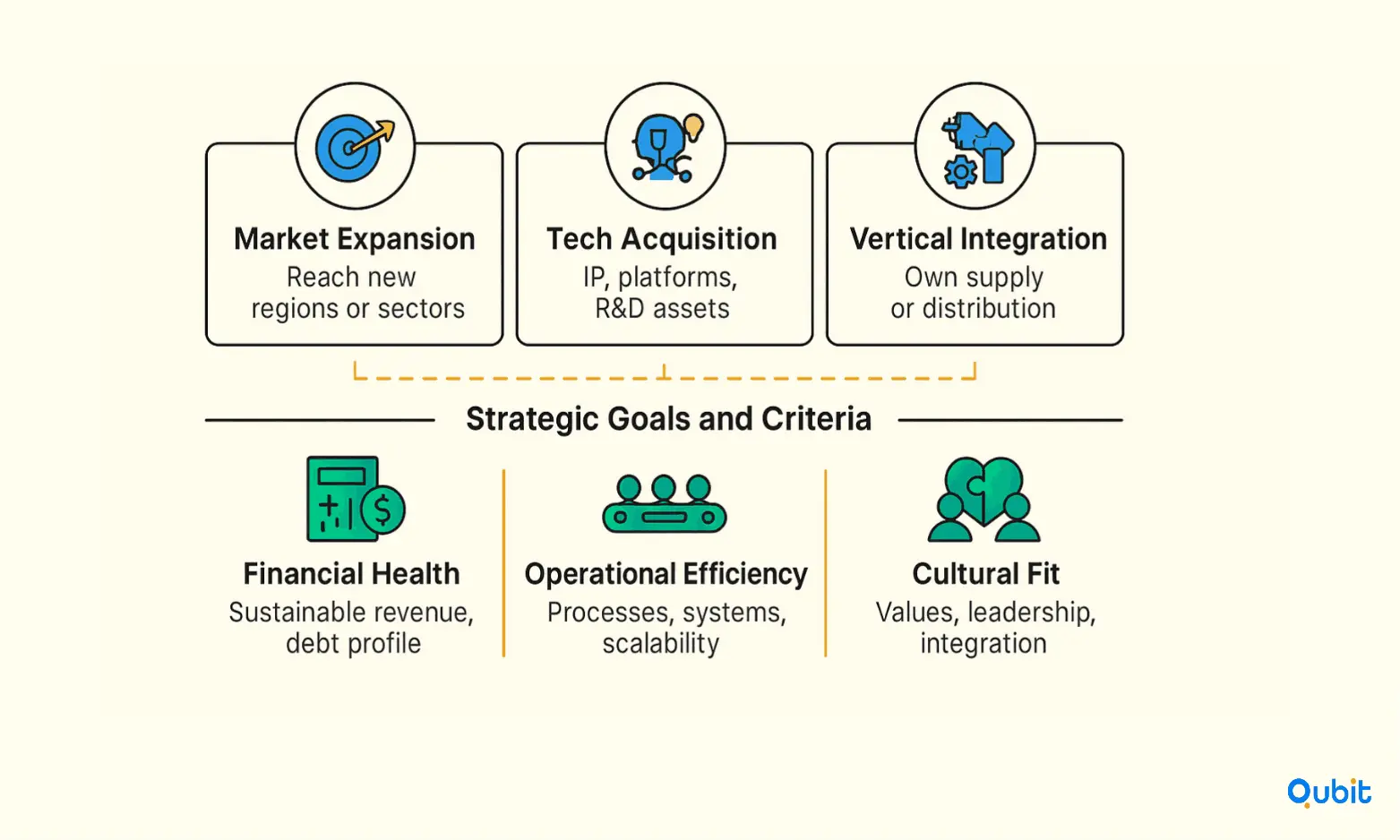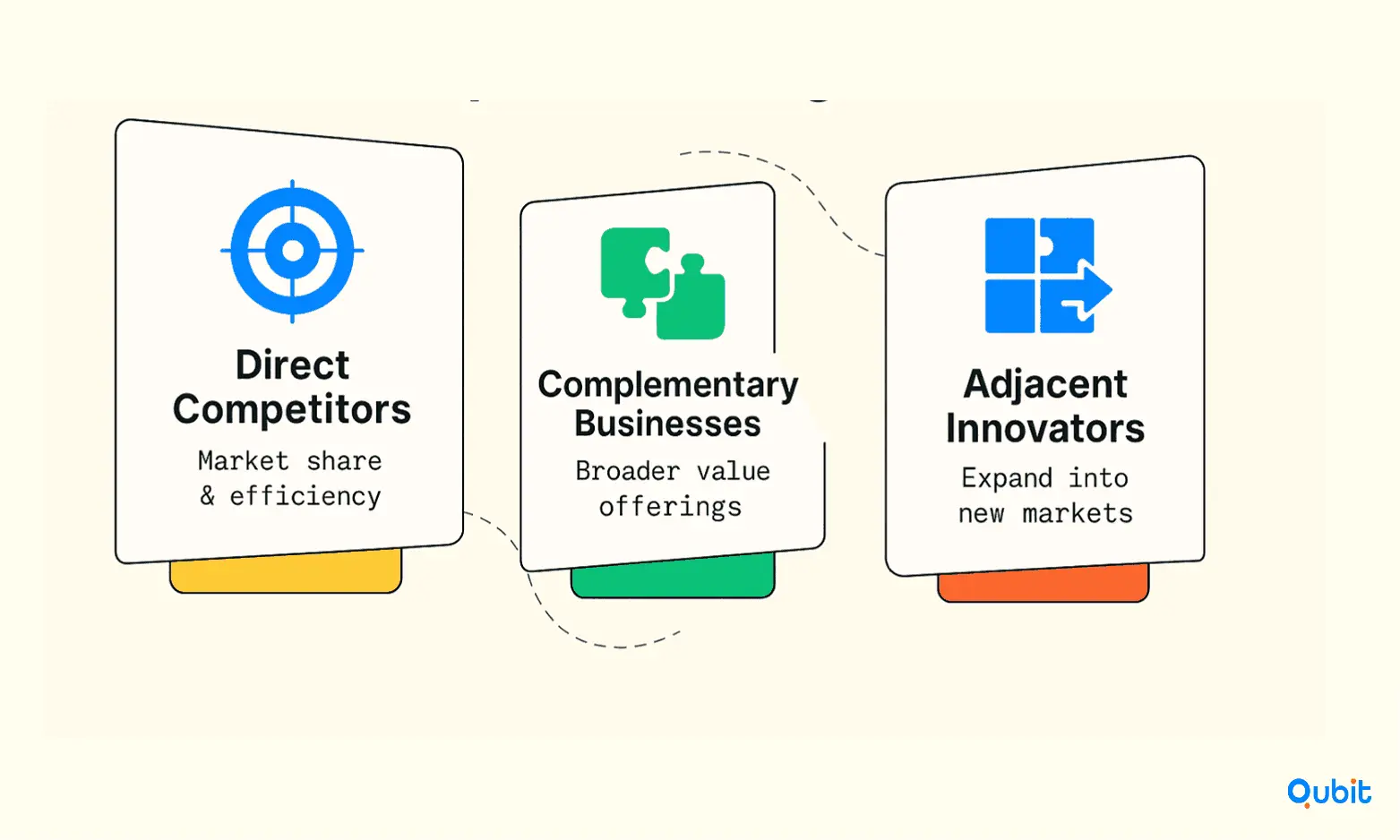Market mapping resources are rapidly expanding. In 2024 and 2025, over 300 AI market maps were compiled across sectors, consolidating competitive analysis for investors. These comprehensive resources enable sharper opportunity identification and comparative evaluation within emerging industries.
By systematically analyzing industries, competitors, and market trends, investors can pinpoint businesses that align with their strategic goals. This approach not only streamlines the search for acquisition targets but also provides a comprehensive understanding of the competitive landscape.
This article will guide you through innovative techniques for market mapping, offering actionable insights into goal setting, market research, and target evaluation.
Set M&A Goals and Criteria
Establishing clear goals and criteria is the cornerstone of a successful acquisition strategy. Every acquisition should serve a well-defined purpose that aligns with your long-term objectives, whether it’s entering new markets, acquiring innovative technology, or achieving vertical integration (combining multiple stages of production or distribution in one company). Without this clarity, the process of identifying and evaluating potential targets can become unfocused and inefficient.

Strategic objectives should drive the selection process. For instance, if market expansion is the goal, the target company’s customer base and geographic reach become critical factors. Similarly, when technology acquisition is the priority, the focus shifts to intellectual property and R&D capabilities. Beyond strategic alignment, evaluation criteria must also encompass financial health, operational efficiency, and cultural compatibility. These elements ensure that the acquisition not only meets immediate needs but also integrates seamlessly into your existing operations.
Subtle differences emerge when you compare these mapping techniques with startup acquisition vs partnership, offering clarity on how investors weigh acquisition decisions alongside potential partnerships. By setting clear goals and criteria, you can streamline the decision-making process and maximize the value of your M&A efforts.
Research the Market
Identifying the right market opportunities begins with a thorough analysis of industry trends, growth rates, and regulatory updates. By examining these factors, businesses can pinpoint emerging sectors that align with their acquisition goals. For instance, exploring government policies and adoption rates in the renewable energy sector can reveal potential growth areas. Such insights not only highlight opportunities but also provide a foundation for strategic decision-making.
Current investment trends are reshaping the landscape for market opportunity research. Budget 2025 commits $280 billion to infrastructure over five years, targeting innovation and resilience. This allocation signals high-growth sectors for investors utilizing market mapping.
Modern tools have revolutionized market research, offering precision and depth. AI-driven analytics and financial databases enable businesses to access quantitative data, making it easier to assess market dynamics accurately. These tools help uncover patterns in technology adoption and industry expansion, ensuring that decisions are backed by reliable data.
Timing is equally critical when evaluating market trends. A clear timeline for executing strategies is provided when addressing the planning startup acquisition timeline, which aligns with the methodical approach discussed in this guide. By combining data-driven insights with strategic timing, businesses can position themselves to capitalize on the most promising opportunities.
The Value of Ongoing Market Map Updates
Building on these research practices, maintaining a dynamic market map is crucial for sustained M&A success. Regularly updating your analysis with new funding events, M&A transactions, and regulatory changes ensures your insights remain actionable. This process helps identify emerging threats and opportunities that static research might miss.
By treating market mapping as an ongoing discipline, businesses can adapt quickly to industry shifts and refine their acquisition strategies. Your detailed exploration of market mapping naturally complements the insights found in startup acquisition strategies, providing a broader framework within which to consider early-stage investments.
Identify Potential Acquisition Targets
Finding the right acquisition targets requires a strategic approach that combines technology, industry expertise, and proactive relationship-building. Platforms like Grata simplify this process by using AI-powered tools to filter candidates based on industry, ownership structure, and revenue. This enables businesses to compile a focused list of prospects that align with their strategic objectives. To experience Grata’s AI-driven deal sourcing firsthand, consider clicking the ‘Schedule a demo’ button on their platform.
Industry networks and advisors also play a pivotal role in uncovering exclusive opportunities. These connections often provide access to off-market deals that might otherwise remain hidden. Staying informed about industry news is equally important, as it allows businesses to identify emerging acquisition opportunities before competitors.
AI and data analytics further enhance the screening process by consolidating qualitative and quantitative data into actionable insights. Tools like Cyndx Finder empower businesses to swiftly identify and analyze potential candidates, streamlining the discovery process.
Competitor analysis offers another valuable perspective. By examining market positioning and gaps, businesses can uncover acquisition prospects that strengthen their competitive edge. However, clearly defined M&A criteria are essential for narrowing down the list effectively. Factors such as cultural and operational alignment should be prioritized to ensure smooth post-acquisition integration.
Finally, proactive relationship-building is key. Establishing trust with potential targets early on can open doors for meaningful discussions and accelerate deal timelines. For additional insights on thriving in crowded acquisition markets, explore our competitive market acquisition strategy
Assess and Evaluate Targets
Identifying the right investment opportunities begins with a thorough evaluation of financial and operational metrics. Revenue thresholds, such as $10M–$50M in annual revenue, serve as a baseline for assessing a target’s financial viability. This range ensures that potential investments align with the scale required for platform growth.
For richer target evaluation, ecosystems are now benchmarked at global scale. The 2025 global index evaluated 288 cities in 69 countries for investment attractiveness. Such indices enable more strategic comparisons and informed acquisition targeting.
Targets should demonstrate a minimum of 15% EBITDA (Earnings Before Interest, Taxes, Depreciation, and Amortization) margins. These benchmarks highlight financial health and provide insight into business model sustainability.
Incorporating broader metrics, such as overall profitability and operational performance, strengthens the evaluation process. Investors can use these indicators to identify businesses that align with strategic goals and long-term growth potential.
For further insights into aligning target evaluations with fund objectives, explore how to build an acquisition strategy. This resource connects evaluation criteria to broader strategic planning.
Weighing Qualitative Factors in Target Evaluation
Beyond financial and operational metrics, incorporating qualitative assessments is essential for thorough target evaluation. Factors like cultural compatibility and operational synergy can significantly influence post-acquisition integration and value creation. These elements often determine whether strategic objectives are fully realized. Balancing quantitative analysis with qualitative insights leads to more informed and resilient acquisition decisions.
Refine and Rank Targets
Once potential targets are identified, the next step is to refine and rank them to ensure alignment with strategic goals. This process involves evaluating each target against a set of predefined criteria, such as market potential, competitive positioning, and resource compatibility. By narrowing the focus, businesses can prioritize opportunities that offer the highest value and feasibility.
Quantitative analysis plays a crucial role in this stage. Metrics such as revenue projections, cost implications, and risk assessments provide a data-driven foundation for decision-making. Combining these insights with qualitative factors, like cultural fit or long-term growth potential, creates a balanced approach to ranking.
A structured ranking methodology ensures clarity and consistency. For instance, scoring systems or weighted matrices can help compare targets objectively. This systematic refinement not only streamlines decision-making but also enhances the likelihood of achieving desired outcomes.
Multi-Criteria Scoring Framework for Target Ranking
Deal Valuation
Evaluating the worth of a potential acquisition target requires a blend of precision and insight. By employing robust valuation methods and analyzing market data, businesses can uncover the fair pricing of an opportunity. This process involves assessing financial statements, understanding industry trends, and considering the strategic value the acquisition brings to the table.
A comprehensive valuation approach often includes discounted cash flow (DCF) analysis, comparable company analysis, and precedent transaction analysis. These methods provide a multi-dimensional view of the target's financial health and future potential. Additionally, market data such as industry benchmarks and competitor performance can offer valuable context, ensuring that the valuation aligns with current economic conditions.
Accurate deal valuation is not just about numbers; it’s about understanding the broader implications of the acquisition. With the right tools and expertise, businesses can make informed decisions that maximize their investment potential.
Types of Potential Acquisition Targets
Acquisition targets can vary widely, each offering unique strategic advantages. Identifying the right category of business to acquire is crucial for achieving long-term goals.

One common type of acquisition target is a direct competitor. Acquiring a competitor can help expand market share, reduce competition, and unlock cost efficiencies. For instance, a Regional HVAC provider successfully acquired a competing firm to broaden its geographic footprint and streamline operations. This approach is particularly effective for businesses aiming to strengthen their regional presence.
Another category includes complementary businesses. These are companies that offer products or services aligning with, but not directly competing against, your offerings. Such acquisitions can enhance customer value by creating a more comprehensive portfolio.
Additionally, businesses in adjacent industries or those with innovative technologies can serve as strategic targets, enabling diversification or entry into new markets. Selecting the right type of acquisition target ensures alignment with your growth strategy and maximizes the benefits of the deal.
Innovative public-private partnerships now redefine strategic targeting. The Small Business Investment Company Critical Technologies Initiative launched in 2023 with the Small Business Administration. It has rapidly guided capital toward Department of Defense critical technology priorities. This model illustrates a modern category of acquisition: aligning with strategic government initiatives to reach emerging markets.
Challenges and Risks in Acquiring Targets
Acquisitions often come with a unique set of challenges that can impact their success. One of the most significant hurdles is the integration of the acquired company into the existing structure. Differences in corporate culture, operational systems, and management styles can create friction, potentially delaying the realization of synergies.
Market uncertainties also play a critical role in complicating acquisitions. Shifts in consumer demand, regulatory changes, or unexpected economic downturns can undermine the anticipated benefits of the deal. Additionally, overestimating the target company's value or underestimating the costs of integration can lead to financial strain.
Another common risk is employee retention. Key personnel from the acquired company may feel uncertain about their roles, leading to turnover that disrupts operations. Addressing these challenges requires thorough due diligence, clear communication, and a well-structured integration plan to mitigate risks and maximize the potential of the acquisition.
M&A Tools and Technology Solutions
The scale of digital transformation is evident in financial markets. By mid-2025, global assets under management reached $147 trillion, reflecting rapid adoption of tech-driven solutions. M&A technology now operates within this unprecedented scope, driving further innovation.
Modern mergers and acquisitions (M&A) demand precision and efficiency, and technology has become a cornerstone in achieving both. From advanced analytics platforms to AI-driven decision-making tools, businesses now have access to solutions that simplify complex processes and enhance strategic outcomes.
One standout innovation is virtual data rooms (VDRs), which provide secure environments for sharing sensitive documents during due diligence. These platforms not only ensure confidentiality but also streamline collaboration among stakeholders. Additionally, predictive analytics tools are empowering companies to forecast market trends, assess risks, and identify synergies with greater accuracy.
Workflow automation tools are another game-changer, reducing manual tasks and accelerating timelines. By integrating these technologies, organizations can focus on strategic priorities rather than operational bottlenecks.
Conclusion
Identifying acquisition targets requires a blend of strategic thinking and technological innovation. Throughout this blog, we explored key strategies for market mapping and emphasized how advanced tools can refine the search for startups that align with your investment goals. Combining traditional methods with cutting-edge technology ensures a more comprehensive and efficient discovery process.
At Qubit Capital, we specialize in startup scouting to help investors uncover opportunities tailored to their objectives. If you're ready to explore impactful acquisition possibilities, connect with us today.
Key Takeaways
- Clear M&A goals and criteria are fundamental to effective target identification.
- Comprehensive market research, including trend analysis and data tools, is essential.
- Leveraging digital platforms and networks enhances the discovery of acquisition targets.
- Rigorous financial and strategic evaluations inform optimal target ranking.
- Advanced M&A tools streamline the decision-making process and mitigate risks.
Frequently asked Questions
How does market mapping help investors in M&A?
Market mapping enables investors to visualize competitor landscapes, spot emerging trends, and efficiently identify acquisition targets.






